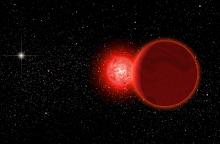Listen to today's episode of StarDate on the web the same day it airs in high-quality streaming audio without any extra ads or announcements. Choose a $8 one-month pass, or listen every day for a year for just $30.
You are here
Alnilam
The stars of Orion’s Belt are really superstars. All three of them are among the biggest, heaviest, and brightest stars in the entire galaxy. And the star at the middle of the belt could be the most impressive of the three.
Alnilam is at least 30 times the mass of the Sun, and 275,000 times brighter. But it could be twice as massive as that, and three times as bright.
The wiggle room is caused by uncertainty in the star’s distance. Most research says it’s about 1350 light-years away. But a second look at measurements made by a space telescope put the distance at almost two thousand light-years. The farther away the star is, the bigger and brighter it is.
Regardless of the distance, there’s no doubt that Alnilam and the other stars of the belt are monsters. Because of their great heft, they’re “fusing” the elements in their cores at a furious rate. That creates enormous amounts of energy — the reason the stars are so bright.
That also creates a plethora of chemical elements, as lighter elements fuse together to make heavier ones. When the stars die, they’ll expel many of those elements into space, providing the raw materials for new stars and planets; we’ll have more about that tomorrow.
In the meantime, look for Orion’s Belt in the south-southwest as night falls, and dropping down the southwestern sky later on. The belt is a short line of three moderately bright stars. Orion's brightest stars line up above and below the belt.
Script by Damond Benningfield






